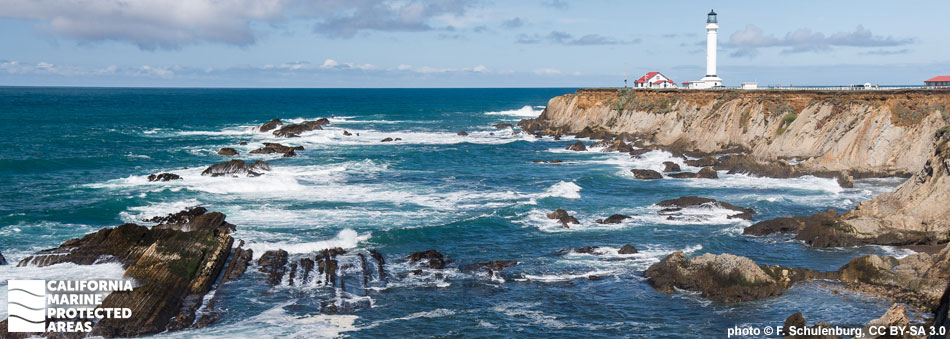
Overview
The small city of Point Arena sits on the rugged Mendocino coast 150 miles north of San Francisco. About five miles north of Point Arena, a headland bearing the same name juts out into the Pacific. Point Arena is often cool and shrouded in fog due to strong upwelling of cold ocean waters. Three marine protected areas (MPAs) encompass the biologically diverse and productive marine environment here: Point Arena State Marine Reserve (SMR), Point Arena State Marine Conservation Area (SMCA), and Sea Lion Cove SMCA.
Covering around four square miles of nearshore ecosystems, Point Arena SMR extends from shore to depths of more than 170 feet. The seafloor topography of the SMR is extremely complex, with rock walls, cobbled reefs, pinnacles, sheer cliffs, caverns, and a large area of deep, sandy seafloor. Point Arena SMR is located near shore, and encompasses tidepools, rocky shores, and kelp beds.
Covering nearly seven square miles of nearshore reef and deep-water ecosystems, Point Arena SMCA lies along the SMR's western boundary, and extends seaward to the 3-mile state waters boundary. The SMCA drops from 150 to over 300 feet deep, with sheer walls, rocky reefs, and large swaths of sand.
Just to the south of the Point Arena SMR and SMCA, Sea Lion Cove SMCA protects about a quarter square mile of primarily rocky seafloor and kelp forest habitat, ranging from shore to depths of around 40 feet. In the aptly named SMCA, sea lions are often found resting on nearshore rocks.
Diverse habitats combined with Point Arena’s strong upwelling and the resulting biodiversity make these MPAs a popular destination for whale watchers, birders, beachgoers, and scuba divers.
Regulations
Point Arena SMR
It is unlawful to injure, damage, take, or possess any living, geological, or cultural marine resource.
California Code of Regulations Title 14, Section 632(b)(28)(opens in new tab)
Point Arena SMCA
It is unlawful to injure, damage, take, or possess any living, geological, or cultural marine resource, EXCEPT:
Recreational and commercial take of salmon by trolling is allowed.
California Code of Regulations Title 14, Section 632(b)(29)(opens in new tab)
Sea Lion Cove SMCA
It is unlawful to injure, damage, take, or possess any living, geological, or cultural marine resource, EXCEPT:
Recreational and commercial take of finfish is allowed.
California Code of Regulations Title 14, Section 632(b)(30)(opens in new tab)
Quick Facts
Point Arena SMR
MPA size: 4.38 square miles
Shoreline span: 2.3 miles
Depth range: 0 to 173 feet
Habitat composition*:
- Rock: 3.61 square miles
- Sand/mud: 2.49 square miles
Point Arena SMCA
MPA size: 6.74 square miles
Depth range: 153 to 324 feet
Habitat composition*:
- Rock: 0.14 square miles
- Sand/mud: 6.59 square miles
Sea Lion Cove SMCA
MPA size: 0.22 square miles
Shoreline span: 0.7 miles
Depth range: 0 to 39 feet
Habitat composition*:
- Rock: 0.56 square miles
- Sand/mud: Less than 0.01 square miles
*Habitat calculations are based on three-dimensional area and may exceed the total MPA area listed above.